By Brady Dale
Purveying my wares
This year, fellow Philadelphia comic maker Dre Time and I got tables at the Small Press Expo. It was my first time as a legit exhibitor at the biggest alt-comix show on the East Coast, and here’s what I learned:
I attended and volunteered at my first SPX in 1999. I had just graduated from college and moved to Washington, D.C. I freaked out as only a 22 year-old can freak out when I learned that there was this huge gathering of underground comics makers in a little hotel just a few Metro stops away. When I got there, I bought something from almost every table I stopped at until I realized I wasn’t going to make it through a full row before I was out of money.
SPX was the first place I had ever saw a mini-comic, even though I had been buying comics since the 2nd grade, off of spinner racks in the grocery stores of Southeast Kansas.
My decision to go all the way with the show this year came out of a move I made a couple years ago. A friend came up with this idea that she called “The Jesus Year.” The story goes that Jesus did most of his significant work in the last year of his life, his 33rd year. So as we each approached 33 we made a pact: we would spend 33 working to define the way we wanted to live for the rest of our lives. And that’s the year I launched my web-comic, Eat The Babies! Since then, I have been pounding out two comics per week on the site and shooting to create enough content for The Google to start taking it seriously.
So I decided to take the plunge and get a table at The Small Press Expo in 2012 and see what happens. I found that your perspective on shows really changes once you become an exhibitor.
First of all, getting on the exhibitor list was a complete roller coaster. We didn’t even get listed as tablers when the exhibitors list came out. Apparently, if you didn’t send in your check on the first day that exhibitor registration opened up, you were out of luck this year. I think I sent ours in on Day 3. After haranguing the volunteer staff endlessly, I found out that we were “very high” on the wait list, but no promises.
Finally, three weeks before the show, we got an email saying we had a spot after all. If you are the cartoonist that flakes and gave us our spot: thanks. That said, I had had all year to finish the mini-comic that I wanted to take to SPX, but without knowing I had a table, it had always fallen to the bottom of my to-do list. I needed to finish the last six pages, get it scanned, neatened up and send it off to the printer. I got it done, but just barely. Good For America made it to SPX with only a few mistakes, and despite the fact that the printer completely screwed up the binding on the first try. It was the first time I had ever sent a comic to get “printed,” ever thought about bleeds or print runs or even doing anything with a color other than black.
At the show, my behavior completely changed from that of an attendee. In the past, I have felt a responsibility to drop a certain amount of money every time I showed up. If I was going to be there, I needed to support the work, and I was careful to make sure that I bought a mix of books from Established, Getting There and Totally Green Creators. Once I was an exhibitor, though, I had no interest in leaving my table. I bought one and only one book the whole show, Dean Haspiel’s new jam, The Last Romantic Anti-Hero, because I have been following Dino close ever since I first discovered him in a long ago SPX Anthology. I also made sure to do it before the show floor opened, so I wouldn’t miss that first eager flush.
I know what fans say: artist who talk to passers-by are annoying. I have said that.
Let me tell you how many books I would have sold all weekend if I hadn’t talked to people: two. Maybe three. I didn’t sell many books – period. But it would have been a complete waste if I hadn’t initiated conversations with people and asked them to open up my comics.
I am a nobody. No one went looking at the exhibitors map and asked themselves: now where’s that guy who draws the television with the arms and legs? Plus, my stuff looks really rough, really sketchy. I don’t have that perfect line or that really elaborate visual imagination that makes some exhibitors’ tables nearly glow. I had to hustle. I had one friend who killed it at the show without a lot of hard selling. But his work is pretty from a mile away. Mine, you gotta give it a second. And at a show with as much going on as SPX had, I had to work to earn that second from passers-by.
SPX is overwhelming. Nevermind the fact that this year nearly all the giants of the field were there. Chris Ware, The Hernandez Brothers and Dan Clowes? Are you kidding? Why even show up if you weren’t going to work it? I thought my secret weapon was going to be my table display. As you can see from the photo above, I made a cardboard cutout of DEATH and gave him a word balloon where The Grim Reaper certified my comic as “The Darkest Satire at SPX.” I thought that this was a bold enough statement that it would get me traffic by sheer dint of people who wanted to call me on the brass of it. What I found? In the visual din of the exhibit hall, people weren’t even seeing it.
People only saw Death if I pointed at him and repeated what the sign said out loud. If you don’t have something ten feet tall or higher behind you, it’s like you don’t even register at this show anymore. Big change from ‘99 when it blew me away how many people were selling photocopied minis for $1.
If I was lucky, then they would pick up Good for America and read a few pages. It’s a pretty raw book, so some people were turned off right away. I have to say, though, folks with the right inclination would always start laughing once they had it open. I got a lot more laughs at my table than I got sales.
Still, that was nice, too. I once read an essay about a mid-list author who had been making his living as a writer for years, but had never seen someone reading one of his books in public. Without shows like SPX, I don’t know how I would ever be able to sell a little comic like Good for America. Even when it didn’t sell, though, it was really gratifying to watch people read it from cover-to-cover and find something to laugh at on every page.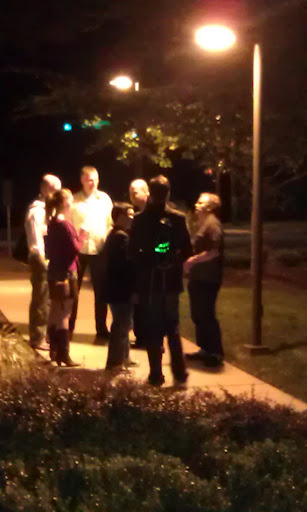
In fact, it was even fun when one woman read three pages and said, “this depresses me too much.”
As long as you are getting a reaction, right?
Don’t get me wrong. If you’re an artist, one of the key reasons to show up at SPX is to network with other cartoonists. No question. It’s just that there is plenty of time to do that off the show floor. That’s what the late night, post-Ignatz partying is for (bring a flask or a backpack full of beers, though – you don’t want to pay the hotel’s booze prices). Once the doors opened, I was all business. Even if folks didn’t buy, I had hoped to have enough of an exchange with them that they might remember to groove on my webcomic later (I don’t think flyering shows really does drive web traffic – but you might as well try).
If I stayed by my table and kept talking to readers as they wandered by, I got a chance to find people that connected with my work. Even if they only did for a second, as they scanned it there in front of me, that’s pretty nice. And it would stay nice, as long as I didn’t do anything silly afterward, like putting my revenues and expenses into a spreadsheet.
—
Brady Dale is the writer and artist behind Eat The Babies! a twice weekly web-comic. He’s also on Twitter.


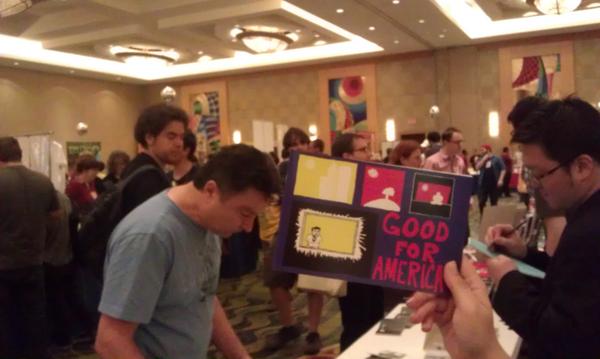
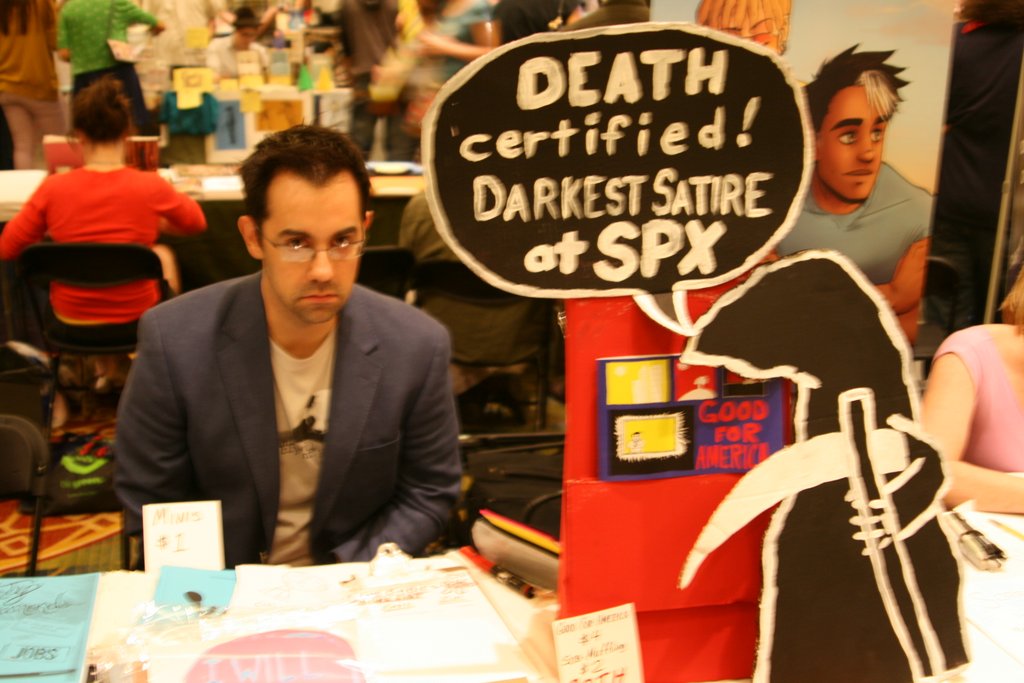
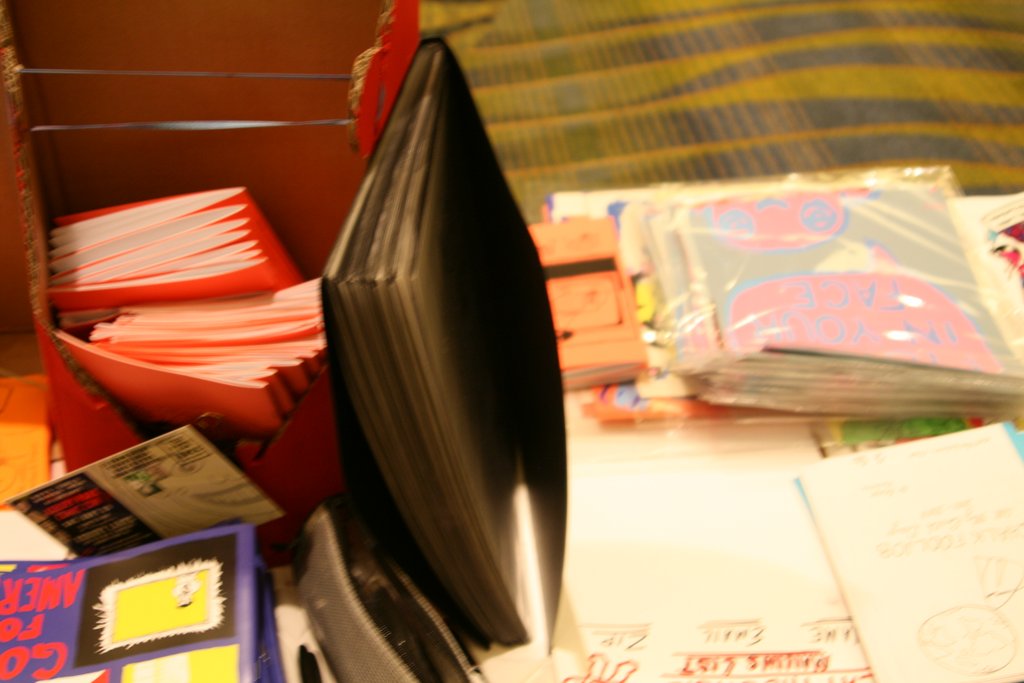
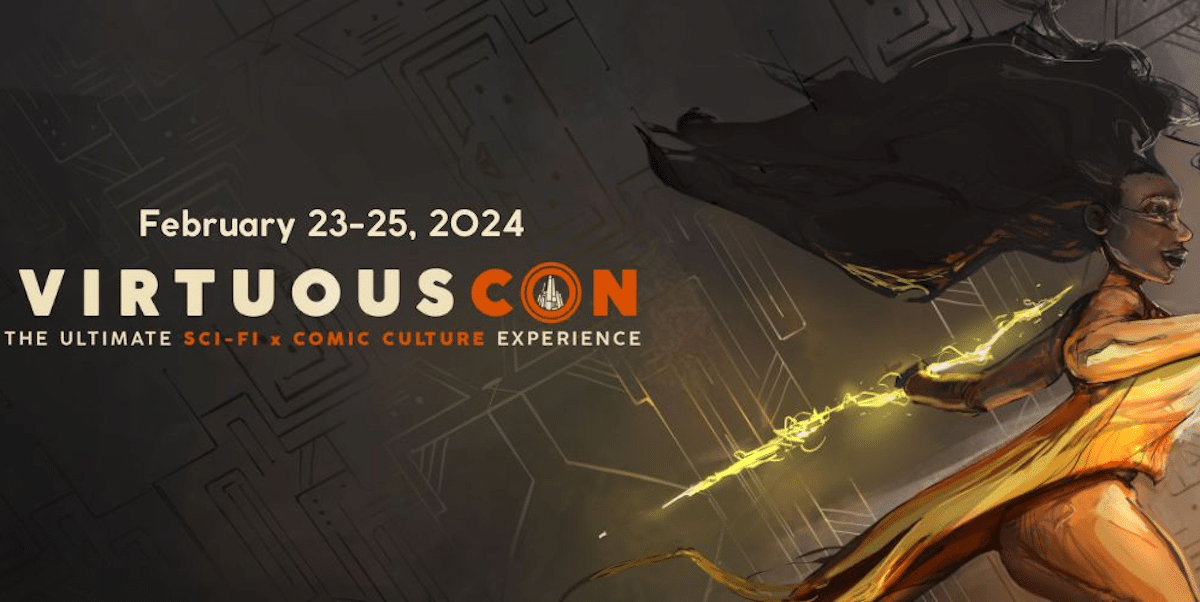





As a five year veteran of exhibiting at SPX, your take-away shouldn’t be that the audience is to blame for your poor sales. It should be that THIS was your first SPX to exhibit or possibly to your first con ever (it’s a bit unclear).
Did you turn in your comic book debut information to SPX who was VERY generous with their ‘due date’ for publicity? Did you utilize Twitter and interact with @SPXcomics (since they RT’d everything). There were plenty of ways to get your comic on the map. From your photo, it looks like someone (you?) are sitting versus standing (rule #1) and look about as happy as Death.
Once on a con’s waiting list, I was once given 24 hours notice of getting a table when its previous owner got sick. That’s how it goes. Try it again next year, aim to make books when you want to make them, printed when you know they are finished versus the biggest deadlines like for a show.
And pardon my excessive use of ‘once’!
Great article. Cons are exhausting. Every con is a little different. As you perfect your pitch, get better at setting up your table, and perfect your product you’ll be able to get the most out of your exhibitor experience. If you’re ever on the West Coast in October, make sure and try exhibiting at A.P.E..
Meanwhile, I love the concept of your Jesus year!!!!
I’m turning 33 in a couple weeks and I’m looking at what promises to be a long year of conventions and publishing. Looking at it as year to define the rest of my life is actually very motivating. I think I’m going to use that!!
Great reading, Brady. Looks like you learned a LOT from your first year in the selling role. And got to meet and influence a lot of potential buyers for next year.
An insightful article (and comments from everyone so far). As it happens, I’ll be exhibiting at my first con as well at next month’s A.P.E. in SF. After years of being a reader, artist, fan, volunteer, and photographer, it will be a new experience for me sitting on the other side of the table.
After planning for 6 months and picking the brains of other exhibitors and creators, and personal observation throughout the years of the Do’s and Don’t’s, I like to think my group and I will have our act down but I’m sure we’ll still miss some things and learn from it.
Any insights anyone wants to offer here in the comments would also be helpful. We already know that A.P.E. isn’t a good Seller’s con, that we’ll be lucky to break even, and it will be more about networking, but I think it is a good Starter Con for us.
And, if you aren’t being pulled in the massive direction of the NYCC that weekend and happen to be in San Francisco for A.P.E. and crave some indy comics, stop on by tables #727 & 728 to check out the BAY AREA SEQUENTIAL ARTIST’s group (BASA) and our wares. (Still getting use to this pimping and self promotion thing.)
Wow, what a cool column. I have to hand it to you – you have brass cajones. I don’t think I’d make my debut at the show with the biggest and bestest names. So congrats to you for having the courage to get out there and do something so big. I hope you learned a lot so your future cons can go better for you financially!
Great write up. Well written, too.
You have my respect, sir. A lot of good insights from the other side of the SPX table.
Selling comics at a convention is a distinct set of skills that requires practice and effort to get good at. You have to start somewhere and the beautiful thing about SPX is that it provides an egalitarian marketplace where everyone gets an equal opportunity to sell to the crowd.
The good news is that now you’ve done it once and (hopefully) have some idea of what kinds of things you can do to improve your chances next time around. Upping the game on your content is one. Display is another. Having a good sales pitch is yet another. Making sure that everyone walks away with something, even if its just a free flier, is another still.
These are all multipliers – things that will increase the chance of successfully building an audience. The point of doing multiple marketing activities is that there is probably not a single “magic bullet” that will solve the problem; aggregate activities help you cast a wider net.
I hope to see you behind the table again next year.
I realized a few days after the show that I stood the WHOLE time during the festival hours. I can’t recall ever doing that before. And my back told me so. (Tom Devlin would be proud. Although I did take a few bites of food here and there.)
Congrats on your first exhibition Brady. Sorry I didn’t get to stop and chat, etc., as when I am out on the floor it is usually a mad dash to accomplish some goal or another.
Thanks everyone! And I hope my dour look in the photo above doesn’t make it look like I was feeling negative. I was trying to make my “cool” face and wanted a shot that included my DEATH display. Turns out I don’t have a cool face. Just a dour face, and this was the best of about 6 not-that-great photos of me at my table. Oh well!
It was totally worth doing, though. And at the end of the day I know that what I really need to do is make better stuff. That’s the trick.
Next time. I’m definitely putting my name in for next year. No question. On Day One, too. Wish me luck!
@PRM definitely make a resolution to live it up in your Jesus year! It really helped me get focused. I wrote a book. Committed to a girl. Started a webcomic and sold a house. w00t!
This was great! Thanks.
I’m honored to have been your sole purchase, Brady. I’m not a very good huckster when it comes to hand-over-fist sales. I usually abandon my table and spend my monies. This time, I decided to self-publish something in print [the first time in a long time] and actually sit/stand behind my table and hawk my wares. Even with some comix cache, it’s a job to sell yourself. Never easy. Plus, I had the fuel of being a guest of the show and was given a hotel room and table space. I sold well [thankfully] but my actual sales wouldn’t have justified table and hotel room costs. Still, it’s good to mingle with your community when possible [it’s a damned shame I wasn’t able to swing by your table and peruse the show] but I was also in town for a couple of other events and showing up to the party isn’t always about stuffing your wallet. Especially for newbies like you. Your job is to toot your horn and get people excited about the new kid on the block. Don’t let this experience discourage you. You did good. Just replace that scowl with a smile and soft sell like Joe Infurnari and I did at our table and, eventually, you’ll discover you have a diehard fanbase. Making comix isn’t for everyone, man. It’s a passionate yet tough choice to indulge but it can be worth it if you can navigate the waters.
Great piece.
My friends and I did pretty well at our first con, but it was in our hometown, Columbia, SC, for Cola-Con which had about 1800 attendees (a surprisingly brilliant comic book/hip-hop show). We personally knew a ton of the people who came up to our table, so it was great training wheels.
Our second show was nine months later at Heroes Con in Charlotte, NC, an exponentially larger show than Cola Con. Our first two days were wildly fun, but it was honestly kind of depressing as far as how weak our sales were. The second night, we pretty much figured this would be our last big show. Still, it was worth it. Sharing elevators with the likes of Jim Rugg and Walt Simonson was so surreal.
I mainly sat at the table during the weekend and drew while my buddies did the pitching. I could hear their pitches evolve, and by the last day, they absolutely nailed it, grabbing the attention of passersby with a single, succinct sentence. We ended up making more money Sunday than Friday and Saturday combined. It was an exhausting, exhilirating day. Now we’re definitely going back for 2013, and we’re gonna take everything we did right that last Sunday and try to kill every day.
It’s not really about the money, but as fun and rewarding as it was, we wouldn’t be able to afford doing this if we didn’t make up any of our costs (we have families, after all). Our success meant we could justify coming back.
Here’s proof that I wasn’t a sourpuss the whole time. Thank you Carolyn Belefski for actually taking a good photo of me:
<img width="300" src="https://sphotos-a.xx.fbcdn.net/hphotos-ash4/285067_10151159917172381_1940207274_n.jpg"
Comments are closed.